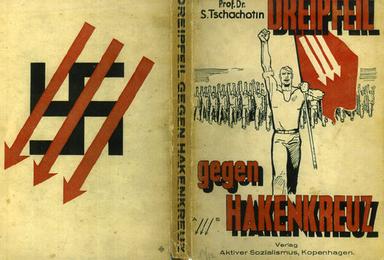Three Arrows
Visual propaganda against fascism
Sergei Chackhotin, the author of the Three Arrows sign, a declared Russian socialist who left the country in 1919, is considered to be one of the fathers of the present-day propaganda. A biologist by education, he worked at the Institute of Experimental Medicine under Ivan Pavlov, however, his biggest passions were sociology, psychology of masses and the study of the impact of propaganda on the behaviour and opinions of population groups. He conducted critical studies of Nazi propaganda and aesthetics and warned others about its dangerous impact long before NSDAP took over power in Germany.
In 1931, Chackhotin together with Carlo Mierendorf, an activist from the Social Democratic Party of Germany, decided to make use of scientific analyses of the Nazi propaganda carried out by the former to create an effective and powerful symbol for the German social democratic movement. They both launched a propaganda campaign entitled ”Three Arrows Against the Swastika” when the three arrows symbol was used for the first time. Chackhotin also wrote a book with the same title in which he analysed the war of symbols and images going on in the Weimer Republic in 1920s and 1930s.
Chackhotin and Mierendorf’s campaign drew heavily on the modern aesthetics of the revolutionary Soviet vanguard artists. According to Chackhotin, the direct inspiration for the symbol was a graffiti he saw in Heidelberg: a swastika painted on the building wall which someone simply crossed out with chalk lines. It was evidence of the visual partisan battle going on in the public space. Chackhotin also believed that the three arrows as a symbol would always be more powerful than the Nazi symbol, no matter whether placed above or below the swastika and even if someone tried to superpose the swastika on the arrows it would still look like as though it had been struck through by the dynamic lines of the anti-Nazi logo Dan S. White, Lost Comrades: Socialists of the Front Generation, 1918-1945, Harvard University Press, Cambridge 1992, s. 94-95.↩︎.
Growing popularity and capturing of the sign
As soon as in June 1932, the three arrows became the official sign of the Iron Front, the anti-Nazi organization of the German Social Democratic Party. According to the authors’ concept and the original interpretation of the sign, the arrows were to symbolize the social democratic movement opposing reaction, capitalism and fascism.
The symbol was also quickly taken over by the Socialist Democratic Party of Germany which used it on the famous election poster of November 1932. In their version, the three arrows pierced the symbols of the German Communist Party, the monarchist faction of the German Centre Party and the National Socialist German Workers’ Party, attacking their leaders: Karl Thälmann, Franz Papen and Adolf Hitler, respectively. In symbolic terms, the poster expresses a protest against monarchism, fascism and national communism – the three ideas posing a threat to socialism and democracy.
The three arrows symbol soon became very popular. German anti-fascist activists (associated with the social democratic Iron Front, the communist Anti-Fascist Action and other political movements) used it in many ways – drawing the sign on building walls, printing it on newspapers, books and leaflets, carried boards with the sign at public demonstrations and painted it on flags and banners. The anti-fascist symbol quickly crossed the borders of Germany and was used already in 1930s by socialists and anti-fascists from all over the world, including numerous pre- and post-war social democratic political parties such as the French branch of the Labour and Socialist International, the French Workers and Peasants’ Socialist Party, the Social Democratic Party of Austria or the General Jewish Labour Bund. The majority of them ceased to exist after WW2 or resigned from the use of the three arrows as their official logo during the period of transformations in the second half of the 20th century. Worth noting is the fact that the three arrows, in a more modern interpretation, remain an element of the logo of the Portuguese Socialist Party to mark the direct reference to the organization’s anti-fascist.
Three arrows today
The three arrows symbol remains to date one of the most important signs of Antifa, the international anti-fascist movement which draws equally on the traditions of social democratic, communist and anarchist organizations of 1930s. At present, the three arrows are most commonly interpreted in accordance with the interpretation offered by the pre-war Anti-Fascist Action as a universal sign of protest against war, fascism and nationalism. This famous symbol is still very much alive and is continuously reinvented, modified, remixed and used in new contexts during protest marches, demonstration and propaganda campaigns all over the world.














